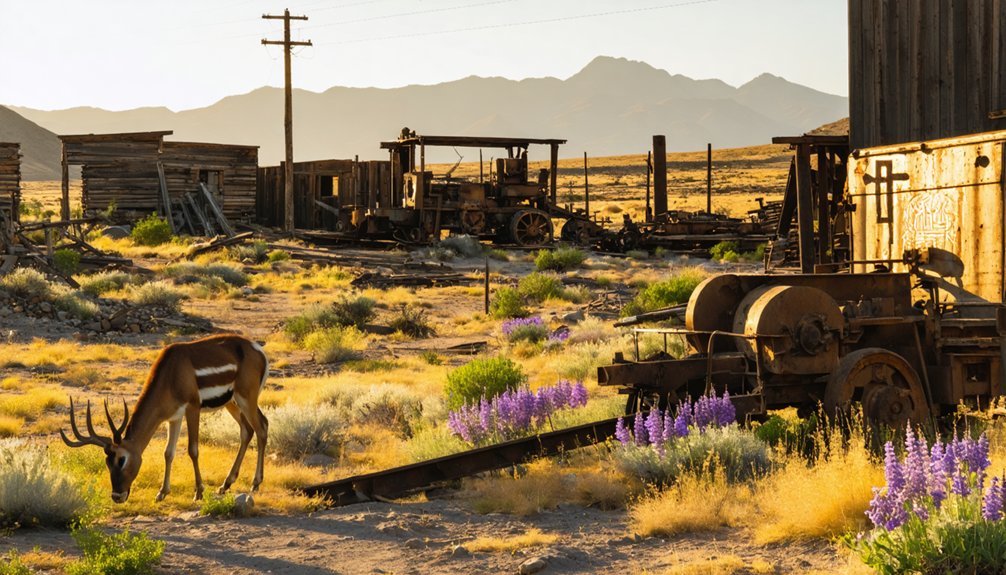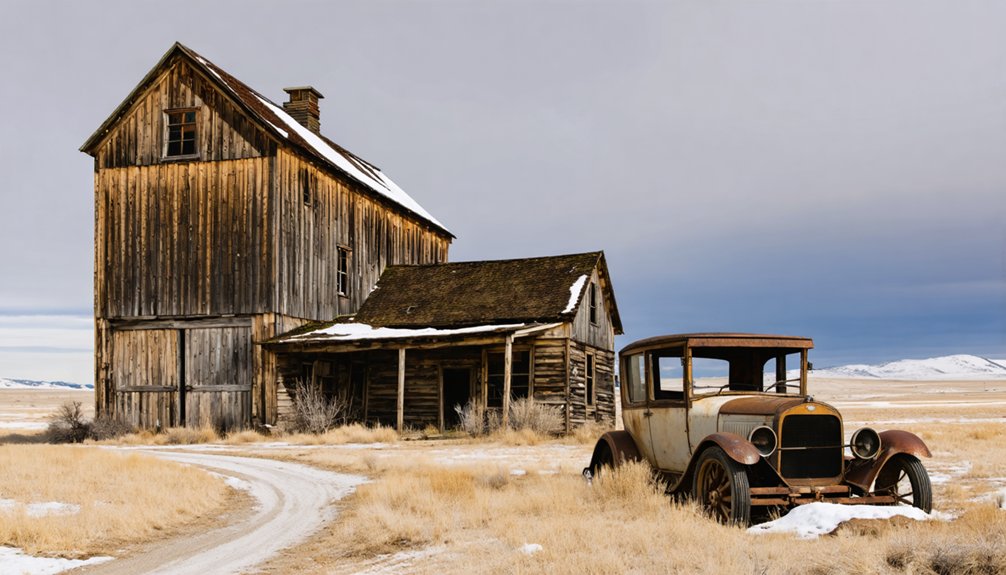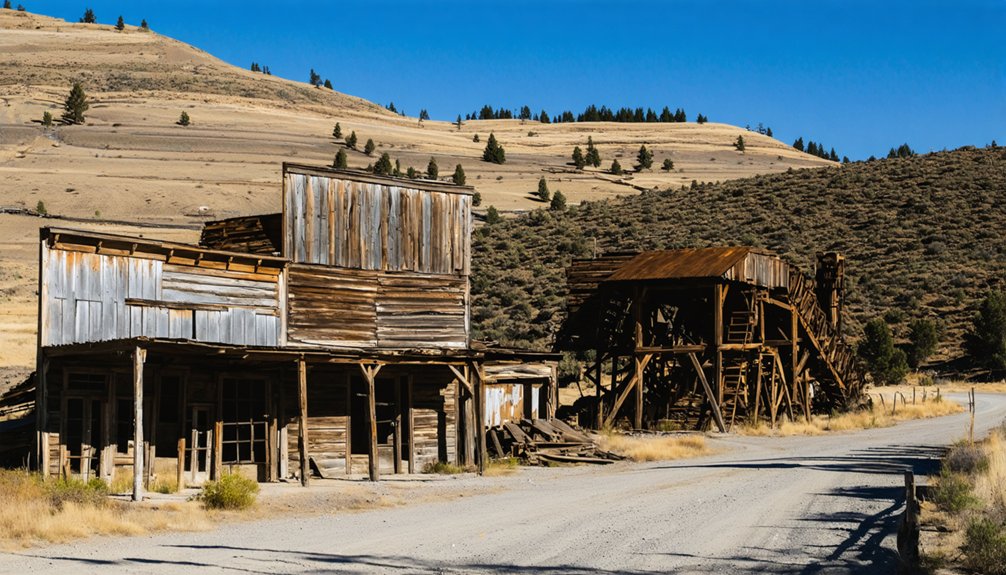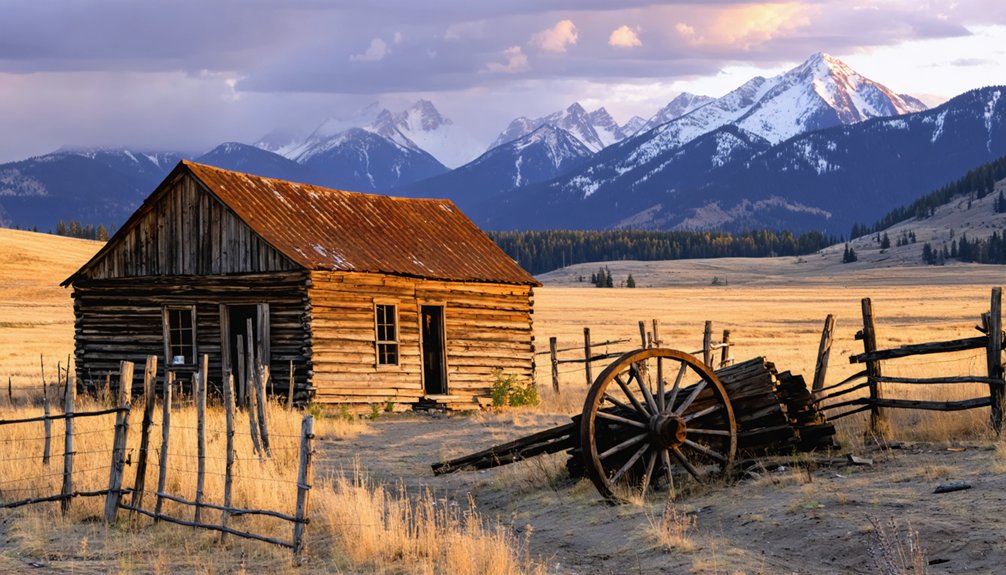You’ll find Vienna’s ghost town nestled in Idaho’s Sawtooth Mountains, where British investors once funded lucrative silver mining operations in the 1880s. The town flourished briefly with 200-300 residents and a twenty-stamp mill, producing over $500,000 in precious metals before legal battles and depleted ore led to its demise. Today, while no original structures remain standing, you can explore mining artifacts and debris that tell the story of this short-lived boomtown’s fascinating past.
Key Takeaways
- Vienna became a bustling mining town in 1878 after gold and silver discoveries, reaching a peak population of 200-300 residents.
- Located in Idaho’s Sawtooth Mountains at 8,200-9,000 feet elevation, Vienna faced harsh weather conditions and challenging access.
- The town thrived from 1882-1885, producing over $500,000 in silver ore from mines including Webfoot, Vienna, and Silver King.
- Legal battles between mining companies in 1885 forced mill closures, leading to Vienna’s decline and eventual abandonment.
- Today, Vienna is a ghost town with no original structures remaining, though mining debris and artifacts can still be found.
The Discovery That Started It All
While many mining booms in Idaho began with a lucky strike, Vienna’s story started methodically in 1878 when prospector Levi Smiley discovered gold along what would become known as Smiley Creek.
Smiley’s initial mineral exploration techniques involved panning for gold with fellow prospector T.B. Mulkey, but their work soon led to the discovery of valuable quartz lodes. By May 1879, Smiley’s prospecting party uncovered deposits rich enough to spark widespread development.
While Smiley and Mulkey began with simple gold panning, their discovery of rich quartz deposits launched Vienna’s mining boom.
You’ll find that E.M. Wilson’s subsequent silver ore discovery proved equally significant, transforming Vienna into a bustling mining center. Word of these finds quickly spread to neighboring camps, spurring a rush into the remote Sawtooth Mountains.
Within months, three distinct mining camps emerged, marking the beginning of Vienna’s brief but remarkable chapter in Idaho’s mining history. The town grew rapidly to include 200-300 residents, establishing itself as a significant mining community in the valley. The installation of a twenty-stamp mill represented a major investment in the town’s future mining operations.
Mining Glory Days: 1879-1885
You’ll find that Vienna’s most prosperous period began in earnest when British investors poured money into the mining operations in 1881, expanding the workforce to 50 men and establishing a productive mill.
During its peak years from 1882-1885, the Vienna district’s mill operated steadily and extracted over $500,000 in silver ore from major producers like the Webfoot, Vienna, Silver King, and Pilgrim mines. This period coincided with Idaho’s thriving lead-silver boom, which generated millions in mineral wealth throughout the region.
The promising boom came to an abrupt halt in May 1885 when a lawsuit between the Vienna Company and Lion Company over a contested claim forced the mill to shut down, marking the beginning of the district’s decline.
Silver Rush Strikes Big
When Levi Smiley’s prospecting party discovered rich silver deposits in May 1879, they ignited one of Idaho’s most promising mining ventures in the Sawtooth Mountains.
You’ll find the legacy of this silver mining boom scattered across the high-elevation landscape, where miners staked claims like the Pilgrim on Beaver Creek at altitudes reaching 9,000 feet.
The historic Vienna Mine produced not only silver but also zinc, gold, and copper as additional valuable resources.
Legal Battle Ends Boom
Although Vienna’s mining operations initially flourished, a devastating legal battle between the Vienna Mining Company and the neighboring Lion Company brought production to an abrupt halt in May 1885.
Like the miners who earned 50 to 80 cents per ton of coal in other mining regions, Vienna’s workers faced similar economic challenges before operations ceased.
The legal implications of contested mining claims created a stalemate that you’d recognize as the beginning of Vienna’s end. While the mining disputes appeared to reach an amicable settlement, the damage was done – the once-prosperous camp never recovered its momentum.
Prior to the shutdown, Vienna’s lead-silver mining had generated an impressive half-million dollars in production.
But after the lawsuit, you’d have found only sporadic ore shipments and minimal activity. The prolonged legal battle contributed greatly to Vienna’s transformation from a booming mining camp into a ghost town, marking the end of its brief but notable mining glory days.
Life in a Mountain Mining Town
Life in Vienna’s mountain mining community embodied the harsh realities faced by countless Western frontier settlements during the mining boom era. You’d have found yourself living in hastily built wooden homes, where your daily challenges included limited access to clean water and basic sanitation. The ethnic and racial divides created social tensions that impacted daily interactions in the community. The company store system forced families to purchase all necessities at inflated prices while keeping them in perpetual debt.
Under strict economic control from mining companies, you’d face hazardous labor conditions in the mines while struggling to maintain community resilience.
Mining towns endured brutal working conditions and corporate dominance, yet communities found strength in their collective resilience.
- Your health risks included exposure to toxic gases and potential mine explosions
- Your children’s educational opportunities were limited, with many working instead of attending school
- Your cultural activities centered around community gatherings and storytelling to maintain morale
Despite these hardships, Vienna’s residents created a tight-knit community, where families supported each other through multitasking and frugal living, demonstrating remarkable adaptability in the face of isolation and company dominance.
Geographic Challenges and Natural Setting
You’ll find Vienna’s extreme mountain setting posed severe challenges, with mining sites perched between 8,200 and 9,000 feet in the rugged Sawtooth Mountains.
The harsh climate delivered an annual snowfall of around 75 inches, making travel across mountain passes like Galena Summit treacherous and often impossible during winter months.
Access to this remote location required traversing difficult terrain via rough roads that could only accommodate high-clearance vehicles, while the final approaches sometimes demanded travel by foot.
After Levi Smiley’s discovery of gold in 1878, the area’s development accelerated despite its challenging geography.
Mountain Access Complications
Reaching Vienna’s ghost town remains presents several formidable geographic challenges, starting with its remote location at 7,602 feet in the rugged Sawtooth Mountains.
You’ll need to navigate mountain routes that wind through the biotite granodiorite terrain, where access difficulties intensify due to geological instability and seasonal weather changes.
The site’s primary access point connects to State Highway 75 near Smiley Creek, but you’ll encounter:
- Hazardous conditions from rockfalls and landslides along joint-set formations
- Seasonal road closures due to harsh mountain weather
- Limited vehicle access through steep, unpaved mountain passages
The area’s geological composition, featuring thin lamprophyric dikes cutting through granodiorite, creates additional navigation challenges.
These natural barriers have historically contributed to Vienna’s isolation and eventual abandonment, making preservation efforts particularly challenging.
Harsh Weather Impacts
Beyond the physical barriers of Vienna’s mountainous terrain lies an equally formidable challenge: the harsh alpine climate that grips this ghost town year-round.
You’ll encounter weather patterns that’ve shaped Vienna’s fate, from heavy snowfall reaching 128% above normal depths to powerful 30+ mph winds that howl through the Sawtooth Mountains’ natural corridors.
Winter hazards dominate life here, with persistent below-freezing temperatures and snowdrifts that blanket the landscape. Modern temperature readings show the area regularly drops to 32°F or below overnight. The area receives an impressive 250 inches of snow annually.
The short summers offer little reprieve, as cool temperatures persist even then.
Spring’s freeze-thaw cycles deteriorate structures, while autumn’s early snowfall signals winter’s swift return.
The site’s geographic isolation amplifies these challenges – you’re exposed to sudden storms, fog, and gusty winds that funnel through steep valleys, making this ghost town a reflection of nature’s raw power.
The Native Shoshone Legacy

Long before Vienna became a ghost town, the Shoshone-Bannock people maintained a rich presence in Idaho for over 12,000 years, establishing deep cultural roots across a vast territory that stretched from Canada to Mexico.
The region’s Shoshone culture revolved around seasonal migrations, following game and gathering resources as extended family bands settled specific areas.
- Western Shoshone groups lived as nomadic foragers
- Northern bands adopted horses, becoming powerful bison hunters
- Language and traditions persisted despite massive territorial losses
You’ll find that the tribal resilience of the Shoshone-Bannock people endured even as Euro-American settlers arrived in the 1800s, bringing profound changes through fur trading at Fort Hall and subsequent land displacement.
Though their ancestral territories diminished, their cultural legacy continues to shape Idaho’s landscape and history.
Mining Operations and Technology
When silver was discovered in the Vienna district in the late 1800s, the area quickly transformed into a bustling mining operation that would produce roughly two million dollars in precious metals.
The underground mining techniques targeted silver-rich veins within mineralized shear zones, also yielding zinc, gold, and copper as valuable by-products.
Miners followed rich silver deposits along fractured rock formations, discovering additional treasures of zinc, gold and copper within.
You’ll find that ore processing centered around a 20-stamp mill, which operated steadily until 1885, reflecting the typical mineral processing technology of the era.
At an elevation of 8,960 feet, the Vienna Mine’s operations required complex logistics for transporting materials via roads from State Highway 75.
While a new mill was constructed in 1917 alongside a mining camp, it never achieved successful operation, marking the end of major extraction attempts.
The Decline of a Boomtown

The thriving mining operations at Vienna met their first major setback in 1885 when the Lion Company filed a lawsuit over contested mining claims.
Though eventually settled, this legal battle shattered the town’s economic resilience and community cohesion, leading to a sharp decline in mining activity and investment.
You’ll find that Vienna’s downfall was marked by three critical factors:
- Persistent legal uncertainties that discouraged new development
- Harsh mountain conditions that complicated year-round operations
- Depletion of profitable ore sources by the late 1880s
What Remains Today
Modern visitors to Vienna’s ghost town site will find little evidence of its once-bustling mining operations, as no original structures remain standing at this remote location in Idaho’s Sawtooth Mountains.
You’ll need to navigate rough terrain and a partially maintained road to reach the main site, where artifact exploration reveals scattered remnants of the town’s mining heritage.
While buildings have vanished, ghost town preservation efforts focus on protecting what’s left: trash dumps that offer glimpses into residents’ daily lives, twisted metal, tin cans, and mining debris.
Through discarded remnants and preserved debris, we glimpse the everyday lives of those who once called this ghost town home.
Historical photographs help visualize Vienna’s former layout, contrasting sharply with today’s overgrown landscape.
The site’s isolation within the Sawtooth National Forest has helped protect these minimal remains, which continue to tell the story of this forgotten mountain community through their scattered presence.
Historical Significance in Idaho Mining

Established during Idaho’s territorial period, Vienna’s mining operations exemplify the dramatic boom-and-bust cycle that characterized 19th-century Western mineral extraction.
You’ll find that Vienna’s mining heritage remains a reflection of the entrepreneurial spirit that drove Idaho’s early development. The site’s economic legacy, generating over half a million dollars during its peak, demonstrates the significant impact these operations had on territorial Idaho’s growth.
- The Vienna Mine operated during a pivotal period of Idaho’s shift from territory to statehood
- Its success helped establish Central Idaho as a notable silver-producing region
- The mine’s history reflects the technical challenges and financial risks inherent in 19th-century mining ventures
Today, Vienna’s remnants serve as a valuable case study of the mining industry’s role in shaping Idaho’s economic and cultural landscape.
Frequently Asked Questions
What Was the Total Population of Vienna During Its Peak Mining Years?
During the mining boom, you’d find approximately 1,000 people living in Vienna before its population decline, as evidenced by the over 200 buildings that supported this thriving mountain community.
Were There Any Notable Crimes or Lawlessness Incidents in Vienna’s History?
You won’t find documented crime incidents or notable law enforcement records from Vienna’s history. While mining rivalries and legal disputes existed, there’s no evidence of significant lawlessness during its brief existence.
What Happened to the Mining Equipment and Machinery After Abandonment?
Like sleeping giants rusting in time, you’ll find most abandoned machinery was left to decay. The remote location meant mining relics stayed put, with minimal salvage and scattered remnants surviving today.
Did Any Specific Diseases or Epidemics Affect the Vienna Mining Community?
You won’t find documented evidence of specific disease outbreaks in Vienna’s mining community, though health impacts from poor sanitation, crowded conditions, and mining hazards likely affected the population.
What Were the Typical Wages for Miners Working in Vienna’s Mines?
You’d think we’d know exact wages from Vienna’s heyday, but records are gone. While wage disparities existed between roles, you’ll find miners likely earned above-average pay for Idaho’s 1880s workforce.
References
- https://history.idaho.gov/wp-content/uploads/0207.pdf
- https://www.wildernessneed.org/wp-content/uploads/Sawtooth-Smiley-Creek-Historic-Page.pdf
- https://www.youtube.com/watch?v=p3HTA8rSHqA
- https://www.samanthastclaire.com/post/traveling-the-road-to-sawtooth-city
- https://www.sawtoothcityidaho.com/history
- https://caspercollege.cvlcollections.org/items/show/9850
- https://www.idahogeology.org/pub/Staff_Reports/2009/SR_09-6.pdf
- https://www.idahogeology.org/pub/Pamphlets/P-21.pdf
- https://www.lib.uidaho.edu/digital/postcards/items/nwpostcards12.html
- https://www.hmdb.org/m.asp?m=110048



